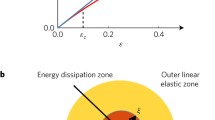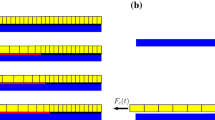Abstract
The propagation of an interfacial crack through a weak plane of a transparent Plexiglas block is studied experimentally. The toughness is controlled artificially by a sand blasting procedure, and fluctuates locally in space like uncorrelated random noise. The block is fractured in mode I at low speed (10’ - 10-4m/s). The crack front is observed optically with a microscope and a high resolution digital camera. During the propagation, the front is pinned by micro-regions of high toughness and becomes rough. Roughness of the crack front is analyzed in terms of self-affinity. The in-plane roughness exponent is shown to be 0.63 ± 0.05. Experimental results are compared to a numerical model. The model reproduces the self-affine behavior of the crack front, i.e., long-range correlations of the roughness. Analogies between mode I and mode III are presented in order to discuss implications of the experimental results for creeping faults. Accordingly, correlations of the slip pattern are shown to exist over scales substantially larger than the asperity sizes
Access this chapter
Tax calculation will be finalised at checkout
Purchases are for personal use only
Preview
Unable to display preview. Download preview PDF.
Similar content being viewed by others
References
Bouchaud, E. (1997)Scaling Properties of CracksJ. Phys.: Cond. Matter94319–4344.
Bouchaud, E., Lapasset, G., and Planes, J. (1990)Fractal Dimension of Fractured Surfaces: A Universal Value?Europhys. Lett.1373–79.
Bouchaud, J. P., Bouchaud, E., Lapasset, G., and Planes, J. (1993)Models of Fractal CracksPhys. Rev. Lett.712240.
Brown, S. R. and Scholz, C. H. (1985)Broad Bandwidth Study of the Topography of Natural Rock SurfacesJ. Geophys. Res.9012,575–12,582.
Cox, B. L. and Wang, J. S. Y. (1993)Fractal Surfaces: Measurement and Application in Earth SciencesFractals187–115.
Delaplace, A., Schmittbuhl, J., and Maley, K. (1999)High Resolution Description of a Crack Front in an Heterogeneous Plexiglas BlockPhys. Rev. E601337–1343.
Fisher, D. (1998)Collective Transport in Random Media: From Superconductors to EarthquakesPhysics Reports301113–150.
Gao, H. and Rice, J. (1986)Shear-stress Intensity Factors for a Planar Crack with Slightly Curved FrontJ. Appl. Mech. 53(4), 774–778.
Gao, H. and Rice, J. R. (1989)A First-order Perturbation Analysis of Crack Trapping by Arrays of ObstaclesASME J. Appl. Mech.56828–836.
Gao, H., Rice, J., and Lee, J. (1991)Penetration of a Quasi-statically Slipping Crack into a Seismogenic Zone of Heterogeneous Fracture-resistanceJ. Geophys. Res. 96(B13), 21,535–21,548.
Lopez, J. and Schmittbuhl, J. (1998)Anomalous Scaling of Fracture SurfacesPhys. Rev. E 57, 6999–7005.
Maloy, K. and Schmittbuhl, J. (2001)Dynamical Instabilities during Slow Crack PropagationPhys. Rev. Lett. submitted.
Maloy, K. J., Hansen, A., Hinrichsen, E. L., and Roux, S. (1992)Experimental Measurements of the Roughness of Brittle CracksPhys. Rev. Lett.68213–215.
Perfettini, H., Schmittbuhl, J., and Vilotte, J. (2001)Slip Correlations on a Creeping FaultGeophys. Res. Lett. 28(10), 2133–2136.
Perrin, G. and Rice, J. N. (1994)Disordering of Dynamic Planar Crack Front in a Model Elastic Medium of Randomly Variable ToughnessJ. Mech. Phys. Solids42(6)1047–1064.
Power, W. L., Tullis, T. E., Brown, S. R., Boitnott, G. N., and Scholz, C. H. (1987)Roughness of Natural Fault SurfacesGeophys. Res. Lett.1429–32.
Ramanathan, S. and Fisher, D. (1997)Dynamics and Instabilities of Planar Tensile Cracks in Heterogeneous MediaPhys. Rev. Lett.79877–880.
Ramanathan, S. and Fisher, D. (1998)Onset of Propagation of Planar Cracks in Heterogeneous MediaPhys. Rev. B586026–6046.
Rice, J. R., Ben-Zion, Y., and Kim, K. (1994)Three-dimensional Perturbation Solution for a Dynamic Planar Crack Moving Unsteadily in a Model Elastic SolidJ. Mech. Phys. Solids42813–843.
Schmittbuhl, J. and Maloy, K. (1997)Direct Observation of a Self-affine Crack PropagationPhys. Rev.Lett.783888–3891.
Schmittbuhl, J. and Vilotte, J. (1999)Interfacial Crack Front Wandering: Influence of Correlated Quenched NoisePhysica A27042–56.
Schmittbuhl, J., Gentier, S., and Roux, S. (1993)Field Measurements of the Roughness of Fault SurfacesGeophys. Res. Lett.20639–641.
Schmittbuhl, J., Roux, S., Vilotte, J., and Maloy, K. (1995a)Interfacial Crack Pinning: Effect of Non-local InteractionsPhys. Rev. Lett.741787–1790.
Schmittbuhl, J., Schmitt, F., and Scxolz, C. (1995b)Scaling Invariance of Crack SurfacesJ. Geophys. Res.1005953–5973.
Schmittbuhl, J., Vilotte, J., and Roux, S. (1995c)Reliability of Self-affine MeasurementsPhys. Rev. E 51, 131–147.
Scxolz, C. H.The Mechanics of Earthquakes and Faulting(Cambridge Univ. Press, New York, 1990). SIMONSEN, I., HANSEN, A., and NES, O. M. (1998)Using Wavelet Transforms for Hurst Exponent DeterminationPhys. Rev. E582779.
Tanguy, A., Gounelle, M., and Roux, S. (1998)From Individual to Collective Pinning: Effect of Long-range Elastic InteractionsPhys. Rev. E 58(2), 1577–1590.
Willis, J. and Movchan, A. (1995)Dynamic Weight functions for a Moving Crack: 1. Mode-I LoadingJ. Mech. Phys. Solids43319–341.
Zapperi, S., Herrmann, H., and Roux, S. (2000), Planar Cracks in the Fuse Model, Eur. Phys. J. B 17(1), 131–136.
Author information
Authors and Affiliations
Editor information
Editors and Affiliations
Rights and permissions
Copyright information
© 2003 Springer Basel AG
About this chapter
Cite this chapter
Schmittbuhl, J., Delaplace, A., Mäl∅y, K.J., Perfettini, H., Vilotte, J.P. (2003). Slow Crack Propagation and Slip Correlations. In: Kümpel, HJ. (eds) Thermo-Hydro-Mechanical Coupling in Fractured Rock. Pageoph Topical Volumes. Birkhäuser, Basel. https://doi.org/10.1007/978-3-0348-8083-1_10
Download citation
DOI: https://doi.org/10.1007/978-3-0348-8083-1_10
Publisher Name: Birkhäuser, Basel
Print ISBN: 978-3-7643-0253-5
Online ISBN: 978-3-0348-8083-1
eBook Packages: Springer Book Archive




